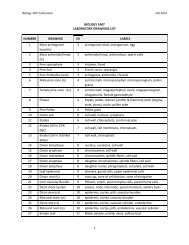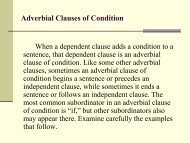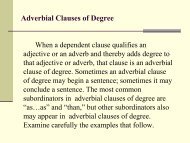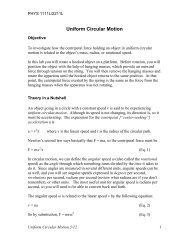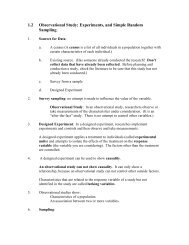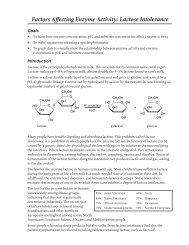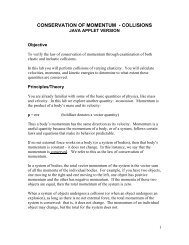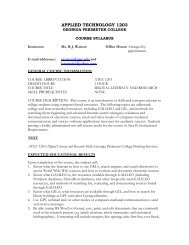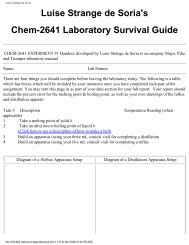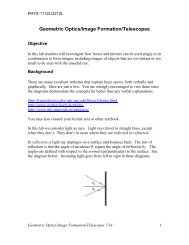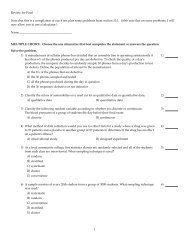Three Domain – 5 Kingdoms Study Guide
Three Domain – 5 Kingdoms Study Guide
Three Domain – 5 Kingdoms Study Guide
You also want an ePaper? Increase the reach of your titles
YUMPU automatically turns print PDFs into web optimized ePapers that Google loves.
Biology 1407-L<strong>Three</strong> <strong>Domain</strong>s- Five <strong>Kingdoms</strong>:Where do the Fungi fit in?<strong>Domain</strong> Archaea (Methane Producers, Hot Springs)<strong>Domain</strong> Eubacteria (Bacteria)Kingdom Prokarya (Cells lacking a nucleus)Symbiotic relationships occur between Bacteria (Rhizobium sp.) and Legume plants for nitrogen fixationthat is characteristic of many plants in the Bean (Legume) Family (Fabaceae). Nitrogen comprises 79%of atmospheric gases, but plants cannot take N out of the air, only from the soil. Many legumes can“fix” N in the soil with the mutualistic help of certain bacteria.<strong>Domain</strong> EukaryaKingdom Protista (Slime Molds, Water Molds, Algae- have characteristics of both plants(cellulose cell walls) and animals (engulf food by surrounding it in amoeba-like fashion).Kingdom Plantae (autotrophic) Representative Divisions:Division Bryophyta (mosses)Division Lycophyta (club mosses)Division Sphenophyta (horsetails)Division Pterophyta (ferns)Division Cycadophyta (cycads)Division Gingkophyta (Ginkgo)Division Coniferophyta (Conifers)Division Anthophyta (flowering plants)Kingdom Animalia (heterotrophic- ingestive heterotrophs) (animals)Kingdom Fungi (heterotrophic-absorptive heterotrophs) (fungi). The body is composed offilaments called hyphae. Hyphae form networks called mycelium. Representative Divisions:Division Zygomycota (Rhizopus sp.)Division Ascomycota (Penicillium sp.)Division Basidiomycota (Mushrooms)Lichens (Fungus + Algae) (98% of the fungus component are Ascomycetes)Fungi may be parasites(feeding on living organisms) or saprophytes (feeding on decaying organicmatter). Without Fungi (and other organisms), the earth would become smothered in dead trees androadkill!Fungi are useful to Earth’s ecosystems and can be beneficial or harmful to man.Beneficial: Mycorrhizae- ectotrophic and endotrophic Yeast Penicillin Truffles and Shitake Mushrooms!
Harmful: Late Blight of Potato (Phytopthora infestans, Division Oomycota) was responsible for the IrishPotato Famine of the 1840’s that killed one million people and caused a mass emigration fromIreland. A more modern famine caused by the fungus Drechslera oryzae, brown spot of rice,resulted in the deaths of two million people in the great Bengal famine of 1942. Dutch Elm Disease- ravaged the American Elm tree in the US when logs infested with the fungusOphiostoma ulmi were brought to Ohio. It is believed that over 77 million Elm trees have diedsince. Chestnut Blight- in the late 1800’s one tree in twenty in the eastern forest was an AmericanChestnut (Castanea dentata). The fungus Cryphonectria parasitica was introduced to New Yorkin 1904 from some Asian Chestnut trees. By 1950, the blight had spread throughout the rangeof the tree, Maine to Alabama and west to the Mississippi River. New sprouts emerging fromthe stumps of dead trees have prevented extinction of the species, but none of these reachmaturity before contracting the fungus. Sudden Oak Death- caused by the fungus Phytophthora ramorum; first described in Europe in1993; introduced to California and fist described there in 1995. The disease is named for thefact that the trees seem to die rapidly once diagnosed: the truth is it takes some time, up to 5years to kill an infected tree. This fungus has secondary host plants that spread and perpetuatethe fungus. Unfortunately, many of these are commonly grown ornamental plants such asCamellias and Rhododendrons. Sudden Oak Death was introduced to Georgia in 2006 but hasnot spread out of quarantined nurseries as far as we know. Smuts and RustsDivision Zygomycota (Lab Manual)Hyphae are haploid; two different mating types fuse hyphae to form a diploid zygospore ; zygosporeundergoes meiosis to form spores that germinate to form haploid hyphae when conditions arefavorable. Draw Here and on Lab Forms.Division Ascomycota (Lab Manual) Penicillium sp. Yeast- reproduces by uneven mitosis (budding= 1 new cell)Division Basidiomycota (Mushrooms) (Lab Manual)Lichens- Mutualism between Fungus and Algae. Two components:Mycobiont <strong>–</strong> Thousands of species of fungi bring water, minerals, a complex vegetative body, and sexualand asexual reproductive structures to the table.Phycobiont- 90% of all Lichens contain one of three species of Algae:Nostoc spTrebouxia spTrentepohlia spThe photosynthetic element (Algae) is only 5-10% of the Lichen body.



